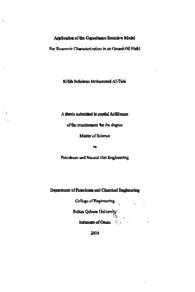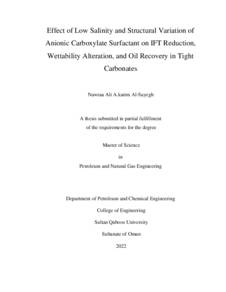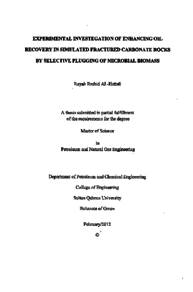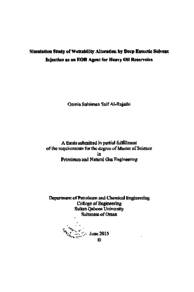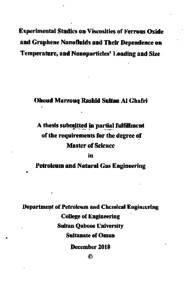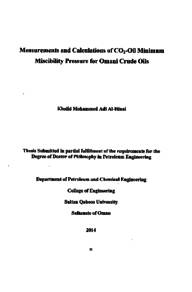Document
Application of the capacitance resistive model for reservoir characterization in an Omani oil field
Publisher
Sultan Qaboos University
Gregorian
2014
Language
English
Subject
English abstract
Reservoir characterization is an essential task in order to predict and optimize oil production under different injection production scenarios. Generally, reservoir simulation is used in reservoir management to evaluate different parameters inside the reservoir. However, it requires many inputs, it is time consuming and it contains large uncertainty in physical and geological properties. Therefore, it is essential to have simpler method that provides quick results.
Capacitance resistive model (CRM) as a fast reservoir simulation technique has been proved to be a very good alternative for the reservoir simulation. The model is derived from the continuity equations to compute producer/injector connection strength whenever desirable well production and injection data are available. Thus, the main input data for this model is only the historical injection and production rate which provides simplicity and speed of calculation. CRM characterizes the reservoir based on the weighting factors and time constants between every pair of injection and production wells which are determined by regression differential equations.
In this work, CRM was used to construct an overview of the physical meaning of CRM parameters. We studied the effect of different geological properties such as permeability, porosity, presence of fractures or damage with different size and the effect of different injection rates on the CRM parameters. We found that the producers that are in a higher permeable area will have higher weight coefficients and lower time constants and vice versa for the producers that are in the low permeable zones. Also, presence of any damage was identified by lower weight coefficients and higher time constants. Presence of fractures was distinguished by higher weight and lower time constants.
We applied this approach to Field A as an example and to real Omani oil field for the reservoir characterization. In Field A, there were high and low permeable areas and we found the location of the fault in the filed by analyzing CRM parameters. In the Omani field, CRM approach was used to determine the high and low permeable zones and then construct the permeability distribution for the whole reservoir to get a general idea about the reservoir by only analyzing injection/production data. It was found that permeability map from CRM is mostly consistent with the permeability map obtained by geostatistics approach. By analyzing CRM parameters, we found that injectors located at the boundary of the reservoir lost more of the injected water when compared to injectors in the interior of the reservoir. In addition, CRM is able to highlight the strength of support from water aquifers at reservoir's boundaries. Also, by CRM we found that 78% of the support is from the injectors and 22% from the aquifers. This is consistent with the known information that 75% of the support is from injector and 25% from the two aquifers. By these analyses we proved the capabilities of CRM in characterizing real field data.
Member of
Resource URL
Arabic abstract
تعتبر دراسة خصائص مكامن النفط واحدة من المواضيع المهمة من أجل التنبؤ بمواقع النفط وتحسن كميات الإنتاج المحتملة تحت سيناريوهات مختلفة من الحقن والإنتاج. و عموما، يتم استخدام برامج محاكاة مكامن النفط في إدارة المكامن لتقييم معلومات مختلفة داخل المكامن. ومع ذلك، فإن هذه البرامج تتطلب الكثير من المدخلات وأنها مضيعة للوقت بالإضافة إلى السلبيات التي تظهر من خلال عدم الدقة في الخصائص الفيزيائية والجيولوجية التي تحاكي الواقع. ولذلك, من الضروري البحث في أسلوب أبسط و يقدم نتائج سريعة.
وقد ثبت أن نموذج مقاوم السعة (CRM) اسلوب سريع وجيد لمحاكاة المكامن النفطية. النموذج مشتق من معادلات الاستمرارية لحساب قوة الاتصال بين آبار الحقن و الإنتاج عندما تتوفر بيانات جيدة عن الإنتاج والحقن. وهكذا، فإن البيانات الرئيسية التي يجب إدخالها لهذا الطراز هو فقط المعدلات التاريخية للحقن والإنتاج التي تعطي هذا النظام البساطة والسرعة في الحساب. نموذج CRM يصف المكامن على أساس عوامل الترجيح والثوابت الزمنية (weighting coefficients and time constants) بين كل زوج من آبار الحقن والإنتاج التي تتحدد بواسطة المعادلات الانحدار التفاضلية.
في هذا العمل، تم استخدام CRM لبناء نظرة عامة عن المعنى الفيزيائي لعوامل CRM. لقد درسنا تأثير خصائص جيولوجية مختلفة مثل النفاذية, المسامية, وجود الكسور وتغير اي ضرر حول الآبار بأحجام مختلفة و أيضا معدلات حقن مختلفة في عوامل CRM. لقد وجدنا إذا كان البئر المنتج في منطقة عالية النفاذية فإنه سيكون لدية weighting coefficient عالي وtime constant منخفض و العكس صحيح للبتر الذي يقع في منطقة ذات نفاذية قليلة. أيضا, وجود أي ضرر يمكن تحديده من قيمة منخفضة ل weighting coefficient و قيمة عالية ل time constant.
بينما وجود الكسور يمكن تميزه من قيمة عالية ل weighting coefficient و قيمة منخفضة ل time constant. لقد طبق هذا النهج إلى حقل أكمثال، وإلى حقل نفط عماني لتحديد خصائص المكامن. في حقل , هناك مناطق عالية و قليلة النفاذية و قدرنا موقع الصدع في الحقل عن طريق عوامل CRM. بينما في الحقل العماني استخدمنا CRM لتحديد المناطق العالية و قليلة النفاذية و بعد ذلك أنشأنا توزيع النفاذية للحقل بأكمله حتى تحصل على فكرة عامة عن الحقل عن طريق تحليل بيانات الحقن و الإنتاج. لقد وجدنا أن خريطة النفاذية من CRM متطابقة تقريبا من خريطة النفاذية المحصول عليها من الإحصاء الجيولوجي. يتحلیل عوامل CRM وجدنا أن أبار الحقن 1, 2 و 7 و التي تقع على حافة الحقل تفقد تقريبا 27, 67 و 10 % على التوالي من الماء المضخ. بالإضافة إلى ذلك, المستودع الجوفي الذي يقع في أعلى الحقل يؤثر على الحقل أكثر من المستودع الجوفي الذي في الأسفل. أيضا, 78% من الدعم للحقل هو من آبار الحقن و 22% من الدعم هو من المستودعات الجوفية. بهذه التحاليل أثبتنا قدرة و براعة CRM من تحديد خصائص الحقول.
وقد ثبت أن نموذج مقاوم السعة (CRM) اسلوب سريع وجيد لمحاكاة المكامن النفطية. النموذج مشتق من معادلات الاستمرارية لحساب قوة الاتصال بين آبار الحقن و الإنتاج عندما تتوفر بيانات جيدة عن الإنتاج والحقن. وهكذا، فإن البيانات الرئيسية التي يجب إدخالها لهذا الطراز هو فقط المعدلات التاريخية للحقن والإنتاج التي تعطي هذا النظام البساطة والسرعة في الحساب. نموذج CRM يصف المكامن على أساس عوامل الترجيح والثوابت الزمنية (weighting coefficients and time constants) بين كل زوج من آبار الحقن والإنتاج التي تتحدد بواسطة المعادلات الانحدار التفاضلية.
في هذا العمل، تم استخدام CRM لبناء نظرة عامة عن المعنى الفيزيائي لعوامل CRM. لقد درسنا تأثير خصائص جيولوجية مختلفة مثل النفاذية, المسامية, وجود الكسور وتغير اي ضرر حول الآبار بأحجام مختلفة و أيضا معدلات حقن مختلفة في عوامل CRM. لقد وجدنا إذا كان البئر المنتج في منطقة عالية النفاذية فإنه سيكون لدية weighting coefficient عالي وtime constant منخفض و العكس صحيح للبتر الذي يقع في منطقة ذات نفاذية قليلة. أيضا, وجود أي ضرر يمكن تحديده من قيمة منخفضة ل weighting coefficient و قيمة عالية ل time constant.
بينما وجود الكسور يمكن تميزه من قيمة عالية ل weighting coefficient و قيمة منخفضة ل time constant. لقد طبق هذا النهج إلى حقل أكمثال، وإلى حقل نفط عماني لتحديد خصائص المكامن. في حقل , هناك مناطق عالية و قليلة النفاذية و قدرنا موقع الصدع في الحقل عن طريق عوامل CRM. بينما في الحقل العماني استخدمنا CRM لتحديد المناطق العالية و قليلة النفاذية و بعد ذلك أنشأنا توزيع النفاذية للحقل بأكمله حتى تحصل على فكرة عامة عن الحقل عن طريق تحليل بيانات الحقن و الإنتاج. لقد وجدنا أن خريطة النفاذية من CRM متطابقة تقريبا من خريطة النفاذية المحصول عليها من الإحصاء الجيولوجي. يتحلیل عوامل CRM وجدنا أن أبار الحقن 1, 2 و 7 و التي تقع على حافة الحقل تفقد تقريبا 27, 67 و 10 % على التوالي من الماء المضخ. بالإضافة إلى ذلك, المستودع الجوفي الذي يقع في أعلى الحقل يؤثر على الحقل أكثر من المستودع الجوفي الذي في الأسفل. أيضا, 78% من الدعم للحقل هو من آبار الحقن و 22% من الدعم هو من المستودعات الجوفية. بهذه التحاليل أثبتنا قدرة و براعة CRM من تحديد خصائص الحقول.
Category
Theses and Dissertations

